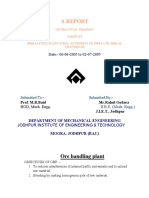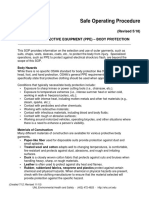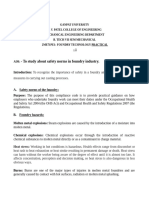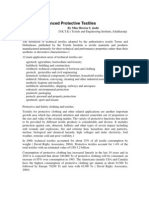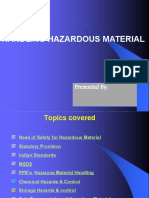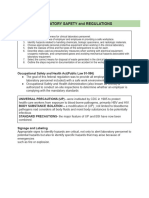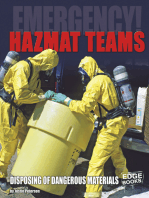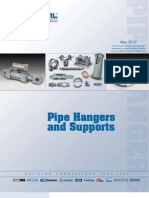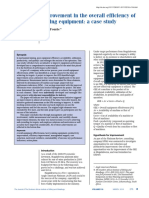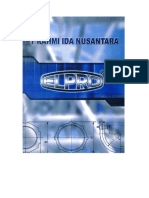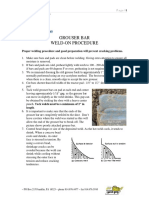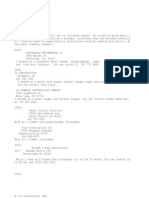0 ratings0% found this document useful (0 votes)
57 viewsGive One Example of A Personal Protective Equipment
Give One Example of A Personal Protective Equipment
Uploaded by
Joshua PincaJoshua P. Pinca completed a homework assignment on personal protective equipment for facilities and building management. Some examples of body protection equipment include laboratory coats, coveralls, vests, and full body suits. Protective clothing comes in different materials like paper-fiber, treated wool, cotton, duck, and leather to protect against hazards like cuts, bruises, chemicals, flames, and temperature extremes. When hazards are present, the material selected for protective clothing should provide protection against the specific hazards.
Copyright:
© All Rights Reserved
Available Formats
Download as PDF, TXT or read online from Scribd
Give One Example of A Personal Protective Equipment
Give One Example of A Personal Protective Equipment
Uploaded by
Joshua Pinca0 ratings0% found this document useful (0 votes)
57 views1 pageJoshua P. Pinca completed a homework assignment on personal protective equipment for facilities and building management. Some examples of body protection equipment include laboratory coats, coveralls, vests, and full body suits. Protective clothing comes in different materials like paper-fiber, treated wool, cotton, duck, and leather to protect against hazards like cuts, bruises, chemicals, flames, and temperature extremes. When hazards are present, the material selected for protective clothing should provide protection against the specific hazards.
Original Description:
PPE facilities management
Original Title
PPE_hw2
Copyright
© © All Rights Reserved
Available Formats
PDF, TXT or read online from Scribd
Share this document
Did you find this document useful?
Is this content inappropriate?
Joshua P. Pinca completed a homework assignment on personal protective equipment for facilities and building management. Some examples of body protection equipment include laboratory coats, coveralls, vests, and full body suits. Protective clothing comes in different materials like paper-fiber, treated wool, cotton, duck, and leather to protect against hazards like cuts, bruises, chemicals, flames, and temperature extremes. When hazards are present, the material selected for protective clothing should provide protection against the specific hazards.
Copyright:
© All Rights Reserved
Available Formats
Download as PDF, TXT or read online from Scribd
Download as pdf or txt
0 ratings0% found this document useful (0 votes)
57 views1 pageGive One Example of A Personal Protective Equipment
Give One Example of A Personal Protective Equipment
Uploaded by
Joshua PincaJoshua P. Pinca completed a homework assignment on personal protective equipment for facilities and building management. Some examples of body protection equipment include laboratory coats, coveralls, vests, and full body suits. Protective clothing comes in different materials like paper-fiber, treated wool, cotton, duck, and leather to protect against hazards like cuts, bruises, chemicals, flames, and temperature extremes. When hazards are present, the material selected for protective clothing should provide protection against the specific hazards.
Copyright:
© All Rights Reserved
Available Formats
Download as PDF, TXT or read online from Scribd
Download as pdf or txt
You are on page 1of 1
Name: Pinca, Joshua P. Homework No.
1
Subj: Facilities / Bldg. Mgmt Time: Sat. 1:30 PM 4:30 PM
Give one example of a personal protective equipment
Body Protection
Employees who face possible bodily injury of any kind that cannot be eliminated through
engineering, work practice or administrative controls, must wear appropriate body protection
while performing their jobs. In addition to cuts and radiation, the following are examples of
workplace hazards that could cause bodily injury:
Temperature extremes;
Hot splashes from molten metals and other hot liquids;
Potential impacts from tools, machinery and materials;
Hazardous chemicals.
There are many varieties of protective clothing available for specific hazards. Employers are
required to ensure that their employees wear personal protective equipment only for the parts
of the body exposed to possible injury. Examples of body protection include laboratory coats,
coveralls, vests, jackets, aprons, surgical gowns and full body suits.
If a hazard assessment indicates a need for full body protection against toxic substances or
harmful physical agents, the clothing should be carefully inspected before each use, it must fit
each employee properly and it must function properly and for the purpose for which it is
intended.
Protective clothing comes in a variety of materials, each effective against particular hazards,
such as:
Paper-like fiber used for disposable suits provide protection against
dust and splashes.
Treated wool and cotton adapts well to changing temperatures, is
comfortable, and fire-resistant and protects against dust, abrasions
and rough and irritating surfaces.
Duck is a closely woven cotton fabric that protects against cuts and
bruises when handling heavy, sharp or rough materials.
Leather is often used to protect
against dry heat and flames.
Rubber, rubberized fabrics, neoprene, and plastics protect against
certain chemicals and physical hazards. When chemical or physical
hazards are present, check with the clothing manufacturer to
ensure that the material selected will provide protection against
the specific hazard.
You might also like
- PP3 - Business of ArchitectureDocument3 pagesPP3 - Business of ArchitectureJoshua PincaNo ratings yet
- Ore Handling Plant Bhilai Steel PlantDocument5 pagesOre Handling Plant Bhilai Steel PlantNaman Shukla0% (2)
- Emily M Northcutt Bikes Executive SummaryDocument4 pagesEmily M Northcutt Bikes Executive Summaryapi-283084318No ratings yet
- Unit - 4Document5 pagesUnit - 4محمد محمدNo ratings yet
- FT PracticalDocument6 pagesFT PracticalPatel JaynamNo ratings yet
- S Ppe Body ProtectionDocument4 pagesS Ppe Body ProtectionJust SleepingNo ratings yet
- Ppe-Guide - EnglishDocument12 pagesPpe-Guide - EnglishUsman AhmadNo ratings yet
- FT PracticalDocument6 pagesFT PracticalPatel JaynamNo ratings yet
- H&sDocument13 pagesH&sawady862No ratings yet
- Ersonal Rotective Quipment : P P E PPEDocument28 pagesErsonal Rotective Quipment : P P E PPEChandni SinghNo ratings yet
- Sub Module 1. PPEDocument20 pagesSub Module 1. PPEMutabazi Igga powersNo ratings yet
- 01-Ppe Eng PDFDocument17 pages01-Ppe Eng PDFZaki AdamouNo ratings yet
- Chapter 3 Workshop TechnologyDocument69 pagesChapter 3 Workshop TechnologyPeter KathuvihNo ratings yet
- Lecture 2Document25 pagesLecture 2Fakhir RehanNo ratings yet
- Agri 7 Lesson 2.2 Personal Protective EquipmentDocument20 pagesAgri 7 Lesson 2.2 Personal Protective EquipmentArianne Joy EsquivelNo ratings yet
- She NotesDocument103 pagesShe Notesmasamvumichael05No ratings yet
- TLE Animal Prod 7&8 Q1 Week 8Document12 pagesTLE Animal Prod 7&8 Q1 Week 8lady catherine enriquezNo ratings yet
- PROTECH Protective TextilesDocument29 pagesPROTECH Protective TextilesAneesha Panda0% (1)
- Presentation 01Document17 pagesPresentation 01Rahim ShahNo ratings yet
- Ief ENDocument4 pagesIef ENszervizNo ratings yet
- Ppe American STDSDocument30 pagesPpe American STDSChetana HamsagarNo ratings yet
- Health and Safety RegulationsDocument4 pagesHealth and Safety RegulationsiangarvinsNo ratings yet
- Ppe AutoDocument1 pagePpe AutoPresley LimonNo ratings yet
- Health, Safety & Environment: Department of Mechanical Engineering Ned University of Engineering & TechnologyDocument41 pagesHealth, Safety & Environment: Department of Mechanical Engineering Ned University of Engineering & TechnologyhyNo ratings yet
- 10 Apply Safety Measures in Farm OperationsDocument20 pages10 Apply Safety Measures in Farm Operationsjetrobillones123No ratings yet
- Osha PpeDocument39 pagesOsha PpeIrawan AliNo ratings yet
- Case Study: Why Is PPE Important?Document6 pagesCase Study: Why Is PPE Important?veyneeNo ratings yet
- Personal Protective Equipment (Ppe)Document14 pagesPersonal Protective Equipment (Ppe)Nelvin Alejo LucasNo ratings yet
- Apply Safety Measures in Farm Operations Animal ProductionDocument18 pagesApply Safety Measures in Farm Operations Animal ProductionCharlote Montefalcon50% (2)
- 1 303Document27 pages1 303davidanani94No ratings yet
- Applying Safety Measures in Farm OperationsDocument15 pagesApplying Safety Measures in Farm OperationsReina Angelica Ofredo VillanuevaNo ratings yet
- Sheet: Personal Protective EquipmentDocument2 pagesSheet: Personal Protective Equipmentin123100% (1)
- Personal Protective Equipment (PPE)Document49 pagesPersonal Protective Equipment (PPE)Gaurav NagpalNo ratings yet
- Concrete Technology 1Document77 pagesConcrete Technology 1Sempiira StevenNo ratings yet
- Chapter 4 Crime Scene Investigation Safetygr. 1 CdiDocument99 pagesChapter 4 Crime Scene Investigation Safetygr. 1 CdiDanica CalucagNo ratings yet
- M.Tech. AMC Lab ManualDocument26 pagesM.Tech. AMC Lab ManualupenderNo ratings yet
- Unit 20 - Personal Protective EquipmentDocument54 pagesUnit 20 - Personal Protective EquipmentAugusto JamesNo ratings yet
- Advance Protective TextilesDocument28 pagesAdvance Protective Textilesimrans1100% (1)
- Jao - SR-BOHS-Course Work # 3Document2 pagesJao - SR-BOHS-Course Work # 3Steven JaoNo ratings yet
- Personal Protective Equipment Selection Guide: Environmental Health & Safety 632-6410 Stony Brook UniversityDocument12 pagesPersonal Protective Equipment Selection Guide: Environmental Health & Safety 632-6410 Stony Brook Universitytramy1413No ratings yet
- Written Report PpeDocument8 pagesWritten Report Pperomeo abuzoNo ratings yet
- Pink Minimalist Digital Marketing PresentationDocument13 pagesPink Minimalist Digital Marketing PresentationArgia Jireh Dadios (Gia)No ratings yet
- of CmaDocument13 pagesof CmaNidhi LanjewarNo ratings yet
- Personal Protective Equipment: Eye and Face Protection: Goggles, Safety Glasses or Face-Shields To Suit TheDocument2 pagesPersonal Protective Equipment: Eye and Face Protection: Goggles, Safety Glasses or Face-Shields To Suit ThedeepakNo ratings yet
- Agricultural Crop Production 11 - Q2 - W6Document6 pagesAgricultural Crop Production 11 - Q2 - W6Jennifer DuranNo ratings yet
- KALOODocument10 pagesKALOOAliNo ratings yet
- Demonstration on PPEDocument6 pagesDemonstration on PPEsantoshprasad303No ratings yet
- Presentation On PPE'sDocument16 pagesPresentation On PPE'sMaqbool Ahmad67% (3)
- MODULE-1-APPLY-SAFETY-PRACTICE-1Document20 pagesMODULE-1-APPLY-SAFETY-PRACTICE-1Kesaiah Shaira GarciaNo ratings yet
- ISOH Part-2Document25 pagesISOH Part-2pixflip16No ratings yet
- Personal Protective Equipment (PPE) : P.ShahDocument48 pagesPersonal Protective Equipment (PPE) : P.Shahairtelkochi12No ratings yet
- CHE135 - Ch1 Intro To Hazard - MII - L1.3Document31 pagesCHE135 - Ch1 Intro To Hazard - MII - L1.3muhammad izzulNo ratings yet
- Submitted To Mohammad Mahfuzur Rahman: Safety Equipment Needed For Any ConstructionDocument9 pagesSubmitted To Mohammad Mahfuzur Rahman: Safety Equipment Needed For Any ConstructionShayan AbagnaleNo ratings yet
- Lesson 3 - Personal Protective EquipmentDocument4 pagesLesson 3 - Personal Protective Equipmentmelanielampera17No ratings yet
- Lab Report # 01: Submitted To: Engr. Faraz Hussain Submitted By: Usman Liaqat 17MME-S1-313Document9 pagesLab Report # 01: Submitted To: Engr. Faraz Hussain Submitted By: Usman Liaqat 17MME-S1-313Usman GujjarNo ratings yet
- Safe Chemical HandlingDocument23 pagesSafe Chemical HandlingUS KuntalNo ratings yet
- Hazard and Risk in FarmDocument20 pagesHazard and Risk in FarmAllysa Mae LavarnezNo ratings yet
- CHE135 - Ch1 Intro To Hazard - MII - L1.3Document31 pagesCHE135 - Ch1 Intro To Hazard - MII - L1.3SyafiyatulMunawarahNo ratings yet
- LABORATORY SAFETY and REGULATIONSDocument7 pagesLABORATORY SAFETY and REGULATIONSAira Jane GamboaNo ratings yet
- Apply Safety PracticesDocument59 pagesApply Safety PracticesEugenio Jr. MatesNo ratings yet
- SWW ProtecWork Catalouge EngDocument104 pagesSWW ProtecWork Catalouge EngFelicitaciones NegroNo ratings yet
- Workplace Vocabulary for Esl Students: With Exercises and TestsFrom EverandWorkplace Vocabulary for Esl Students: With Exercises and TestsNo ratings yet
- Final Chapter 1 - 2 - UnDocument10 pagesFinal Chapter 1 - 2 - UnJoshua PincaNo ratings yet
- A Shared History: Ali Mall and SM CubaoDocument5 pagesA Shared History: Ali Mall and SM CubaoJoshua PincaNo ratings yet
- Rule VIII Light&VentilationDocument45 pagesRule VIII Light&VentilationJoshua PincaNo ratings yet
- CH18題庫Document5 pagesCH18題庫Lin RubyNo ratings yet
- Ma Chapter 5 New Multiple Choice For TestbankDocument4 pagesMa Chapter 5 New Multiple Choice For TestbankJimmy Jamero Jr.100% (1)
- FM 306: Size Reduction and Sieving: ObjectiveDocument6 pagesFM 306: Size Reduction and Sieving: ObjectiveErcille Mae Oraiz PacamoNo ratings yet
- Tugas English 3-12Document7 pagesTugas English 3-12BagelsNo ratings yet
- Vecom - Japanese BlackDocument2 pagesVecom - Japanese Blackdiaccessltd_17172961No ratings yet
- Turbo T TDSDocument2 pagesTurbo T TDSDinesh NathNo ratings yet
- 316L Stainless Steel End Suction Centrifugal PumpsDocument4 pages316L Stainless Steel End Suction Centrifugal Pumpsrodriguez.gaytanNo ratings yet
- Ancorsteel® 4300 PDFDocument3 pagesAncorsteel® 4300 PDFJoydip JoydipNo ratings yet
- Anvil - Pipe Hangers and Supports - May 2010Document244 pagesAnvil - Pipe Hangers and Supports - May 2010kopaukNo ratings yet
- Computer Integrated ManufacturingDocument3 pagesComputer Integrated ManufacturingfarhanjohariNo ratings yet
- Low Pressure CarbDocument6 pagesLow Pressure CarbSinan YıldızNo ratings yet
- Company Profile Presentation of PT. JUHDI SAKTI ENGINEERINGDocument46 pagesCompany Profile Presentation of PT. JUHDI SAKTI ENGINEERINGJuhdi Sakti100% (1)
- Recycling of Demolished BDocument316 pagesRecycling of Demolished BLevi Nascimento100% (1)
- 05Document16 pages05juliokohutNo ratings yet
- Improvement in The Overall Efficiency of Mining Equipment PDFDocument7 pagesImprovement in The Overall Efficiency of Mining Equipment PDFAndres Mujica MorovicNo ratings yet
- Bi Rotator FormDocument8 pagesBi Rotator FormBùi Hắc HảiNo ratings yet
- Objective of MRP and MRP2 in Computer StudyDocument14 pagesObjective of MRP and MRP2 in Computer StudyMostafa FawzyNo ratings yet
- Inventory Models: Single Quantity: 1.purchase Model Without ShortagesDocument6 pagesInventory Models: Single Quantity: 1.purchase Model Without ShortagesmunotmanasNo ratings yet
- Varec 4210A CatalogDocument4 pagesVarec 4210A Catalogking4lifeNo ratings yet
- Vietnam Plastic Industry Report (EN) - VCBS - 2016 PDFDocument21 pagesVietnam Plastic Industry Report (EN) - VCBS - 2016 PDFKhoi NguyenNo ratings yet
- Catalog Elpro Tray LadderDocument104 pagesCatalog Elpro Tray LadderArif Faturohman0% (1)
- Anand Polymers - C1 - MIP Phase 1Document8 pagesAnand Polymers - C1 - MIP Phase 1Akshay JainNo ratings yet
- Welding ProcedureDocument2 pagesWelding ProcedureAndrey GyrychNo ratings yet
- Carpenter/ Framer/drywall/t-Bar CeilingsDocument3 pagesCarpenter/ Framer/drywall/t-Bar Ceilingsapi-122041728No ratings yet
- OfferDocument16 pagesOfferbspgitamNo ratings yet
- Is 8329 1994Document30 pagesIs 8329 1994Madanlal Varada86% (7)
- Modern Manufacturing PracticesDocument2 pagesModern Manufacturing PracticesPradip PatelNo ratings yet

